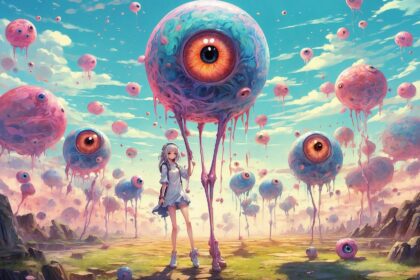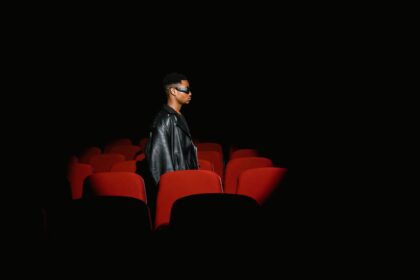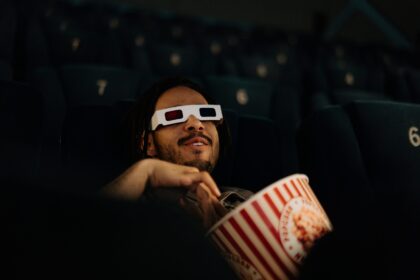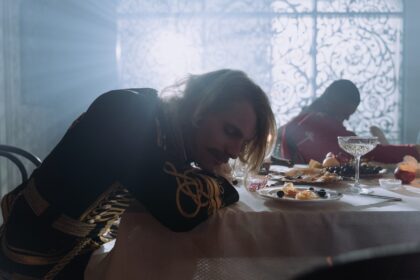Lucid Dreams in Metaphysical Cinema
Let’s step into the metaphysical teleporter, where lucid dreaming is the conduit, whisking us away to a realm where dreams and reality intertwine into a seamless tapestry. Films like What Dreams May Come and Enter the Void guide us on this journey, illuminating the unfathomable depths of consciousness and dimensions that transcend physical reality. Along the way, these narratives provoke profound questions about existence, life after death, and the nature of reality itself.
Dream symbolism, such as the labyrinth in Pan’s Labyrinth, and philosophical implications of navigating the afterlife in ‘What Dreams May Come’ surface as we journey deeper, challenging our perceptions and serving as catalysts for personal growth. These metaphysical adventures blur the lines between reality and the dream world, leaving us longing to navigate such surreal landscapes.
While these movies offer stunning visual spectacles, they also leave enduring imprints that challenge us as viewers to question our own perceptions and test the limits of our subconscious desires. In doing so, we inch closer to unlocking the potential of lucid dreaming—where we, like the characters on screen, can shape our dreams at will.
Pan’s Labyrinth (2006)
Guillermo del Toro’s ‘Pan’s Labyrinth’ is an intricately crafted cinematic masterpiece inspired by his vivid childhood dreams. This unique blend of fantasy and reality unfolds against the somber backdrop of post-Civil War Spain. Inspired by a recurring midnight spectacle from his dreams, del Toro crafted the memorable faun character, a mythical creature that stepped out from behind a grandfather clock.
Though not explicitly focusing on lucid dreaming, the essence of conscious dreaming permeates the narrative. The film employs the dream-like realm to explore themes of reality, imagination, and identity. Young Ofelia’s surreal adventures in the labyrinth mirror the strange yet hyper-aware journeys of lucid dreams. With a thought-provoking story and visually stunning imagery, the film illustrates how lucid dreaming can inspire and shape narratives. ‘Pan’s Labyrinth’ swept up three Academy Awards—Best Art Direction, Best Cinematography, and Best Makeup— solidifying its place as a fantasy cinema masterpiece profoundly imbued with elements of lucidity.
Yesterday’s Children (2000)
In the 2000 TV movie “Yesterday’s Children,” dreams become a time-traveling portal as Jenny Cole, an expectant mother, starts vividly reliving scenes from the 1930s. This is not just dream recall; it’s lucid dreaming with a historical twist. As Mary Sutton, an Irishwoman with stories to tell from a past life, she finds her lucidity intensifying with each episode. Her skepticism wanes as she learns to navigate her past life through this conscious dream state, confronting fears and emotions that have resonated across time.
However, the movie’s real theme lies more in the realm of reincarnation than in the labyrinth of lucid dreaming. It gives a fresh spin on the concept of vivid dreams, serving as gateways to past lives and broadening our perceptions of dream lucidity. Even with its mixed reviews, “Yesterday’s Children” adds a unique perspective on the potential of lucid dreaming, making it an intriguing addition to our list.
Enter the Void (2009)
If there were an Oscar for the trippiest, most psychedelic interpretation of life after death, “Enter the Void” would win hands down. Directed by Gaspar Noé, ‘Enter the Void’ transports viewers on a hypnotic journey through the afterlife of Oscar, a Tokyo-based young American drug dealer. This is not your conventional lucid dream scenario but rather a tour de force of altered consciousness where Oscar uses his newfound lucidity to manipulate his dreams, transmute environments, interact with dream characters, and confront his deepest fears, such as death itself.
Whether he’s soaring above cityscapes, dialoguing with long-lost friends, or reshaping his surroundings, Oscar’s experiences parallel those of an accomplished lucid dreamer. This exploration blurs the boundaries between consciousness and perception, life and death, dream and reality. With its stunning visuals and unconventional narrative, “Enter the Void” is an audacious cinematic spectacle that delves into the realm of dream control and subconscious exploration, capturing the essence of lucid dreaming in an unexpectedly creative way. If you’re open to a wildly different take on dream exploration, don’t miss this ‘void’!
What Dreams May Come (1998)
Let’s pull back the curtain on “What Dreams May Come”, a 1998 visual odyssey directed by Vincent Ward. In this film, Robin Williams steps into the shoes of Chris Nielsen, journeying through an afterlife that his thoughts and emotions actively paint. Although not a tale of lucid dreaming, the film draws some striking parallels. Much like a lucid dreamer, Chris consciously interacts with his ethereal surroundings, twists the reality around him, and even engages with the deceased – think of it as inception, but with a celestial twist.
While critics played a game of tug-of-war with their reviews, the movie’s Oscar-winning visual effects make it a tantalizing treat for the senses. The similarities between Chris’s afterlife escapades and lucid dreaming are hard to overlook – from dream control and awareness to experiencing impossible realities and chatting up with the departed. However, there’s a reminder for us mere mortals – unlike Chris, we can’t linger indefinitely in our dreams, or can we? Now, If the thought of steering your dreams sparks your curiosity, or flying through a mosaic of memories captures your fancy, this movie will surely stir your imagination. But remember, you’ll eventually have to wake up – unless you’ve mastered lucid dreaming!
The Fountain (2006)
If you’ve ever wished your dreams came with a soundtrack by Clint Mansell and visuals that make your brain feel like it’s been dipped in gold, “The Fountain” (2006) is your jam. Directed by Darren Aronofsky, this flick is a trippy, philosophical rollercoaster with Hugh Jackman and Rachel Weisz playing out an epic love story across three different timelines. We’re looking at a metaphysical buffet: love, death, and a healthy serving of the quest for eternal life.
Think of lucid dreaming as a practice run for navigating Aronofsky’s dreamscape. You get to call the shots in lucid dreams, much like our protagonists trying to master their fates across centuries. The film’s dazzling symbolism, featuring the Tree of Life and cosmic voyages, parallels the surreal, symbolic nature of lucid dreams. So, if you’ve ever pondered life’s big questions or just wanted to dream with style, “The Fountain” offers a mind-bending narrative, as if you are trying to remember where you left your keys – in a dream.
Beyond the Black Rainbow (2010)
If “Beyond the Black Rainbow” (2010) were a lucid dream, it’d be the one where you’re stuck in a psychedelic 1980s nightmare, courtesy of an evil scientist with a penchant for dream tech. Directed by Panos Cosmatos, the film explores altered states of consciousness, psychic abilities, and the wild idea of transcending reality through some seriously sketchy technology. Elena, our protagonist, navigates a dream-like state manipulated by Dr. Arboria’s experiments, reflecting the lucid dreamer’s challenge of becoming aware and controlling the dreamscape.
The film’s trippy visuals and bizarre storyline make you question reality faster than you can say, “Is this a dream?” Elena’s journey through this twisted reality is like a masterclass in lucid dreaming gone wrong – aware, but good luck changing anything when the dream boss is a mad scientist. “Beyond the Black Rainbow” is a visual feast that challenges perceptions and leaves you pondering if you’ve stumbled into someone else’s lucid dream, making it a cinematic acid trip you won’t soon forget.
Solaris (2002)
“Solaris” (2002), directed by Steven Soderbergh, plunges into the murky waters of memory, consciousness, and reality. Dr. Chris Kelvin, a psychologist, finds himself on a space station orbiting the mysterious planet Solaris, where he’s greeted by manifestations of his deceased wife, Rheya. Not your typical family reunion! These eerie apparitions push the crew to question what’s real and what’s just Solaris messing with their heads.
This cinematic mind-bender parallels lucid dreaming, where dreamers often ask, “Is this real?” Just as lucid dreamers can control and explore their dreamscape, Solaris takes the crew on a wild ride through their subconscious fears and desires. It’s like lucid dreaming on steroids—where your subconscious doesn’t just whisper your insecurities; it manifests them as full-blown entities sharing your living space. So, next time you’re lucid dreaming, remember: at least your dream characters aren’t being orchestrated by a cosmic puppet master!
Jacob’s Ladder (1990)
If you’re looking for a psychological horror film that’ll leave you questioning your sanity, “Jacob’s Ladder” is your ticket to a one-way trip down a rabbit hole of paranoia and confusion. Directed by Adrian Lyne, this flick follows Jacob Singer, a Vietnam War vet who’s having a seriously bad trip, complete with terrifying hallucinations and flashbacks that’ll make you want to sleep with the lights on.
For us metaphysical explorers and wannabe lucid dreamers, “Jacob’s Ladder” is like a masterclass in what happens when your subconscious throws a rave and invites all your worst fears as DJ. While lucid dreamers aim to control their dreamscape, poor Jacob is more like a ping-pong ball in a tornado of hellish visions. The film dives deep into questions of existence, death, and the nature of reality itself – it’s philosophy class with more demons and less tweed.
The Tree of Life (2011)
Terrence Malick’s “The Tree of Life” is like the cinematic version of that deep, late-night conversation you have with your best mate about the meaning of life, only with way better visuals. This film doesn’t just dabble in metaphysical themes; it dives headfirst into the philosophical deep end, exploring existence, memory, and the cosmic dance of life itself. Picture a 1950s Texas family interspersed with the universe’s origins—sounds trippy, right? It’s like your grandpa’s home movies got mixed up with a documentary on the Big Bang.
The narrative meanders through time and space like a dream after one too many cheese platters, creating a tapestry where the past, present, and future mingle like old friends at a reunion. This dream-like quality mirrors the fluidity of lucid dreaming, where your wildest memories and existential musings can pop in for a chat. This film deeply moved me. Its artistic and poetic approach resonated with me, making it a standout experience that dazzles the eyes and touches the soul. If you’re into movies that make you question your place in the cosmos while dazzling your eyeballs with stunning visuals, “The Tree of Life” is your metaphysical jam.
Films to Dream By
These films explore the boundaries of consciousness, reality, and dreams. They offer more than just entertainment – they provide opportunities for deeper reflection on existence and perception. Whether you’re a film buff or philosophical thinker, these movies offer plenty to ponder on your next viewing.

















